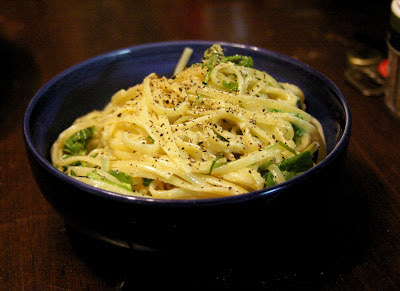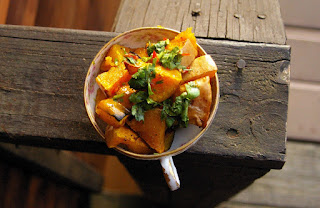Too many people go straight for cutting winter squash in half, adding butter, brown sugar and cinnamon and baking. There's nothing wrong with that, but squash can do so much more. In the last week, I have eaten squash in a Mexican-style rice bowl with beans and rice, a South Indian-style coconut and chick pea curry, on flatbread with eggs and tomato jam, in macaroni and cheese, and in cream puffs. And, of course, plain by the spoonful. It is no coincidence that asquash, one of the Algonquin roots from which the English word squash derives, simply means "eaten."
Roasting squash really is the only way to cook it: simmering it leaves it with a stringy texture and can sap out the flavor and copious nutrients. Roasting, on the other hand, enriches a squash's sweetness and creamy texture. I like to roast squash ahead of time, even when I'm not going to use it immediately, often a few at a time. As long as you're going to be at home for an hour, you can roast a squash. It doesn't need much attention while cooking. It keeps in the fridge for two weeks or so (in the unlikely occurrence that it sticks around that long) and provides instant squashy gratification.
To roast any variety of winter squash, turn on the oven to 375°; cut your squash in half and scoop out the seeds. The seeds, of course, can be roasted on their own for a toasty snack. Lay the halved squash cut side down on a lightly oiled sheet pan. Use foil if you don't feel like soaking/scrubbing later. Let it cook until squash is tender to the touch and the skin has started to brown up some. Depending on how large your squash is, this could be anywhere from 35-60 minutes. Set a timer for 30 minutes, poke the squash at its thickest point and decide how long you want to set the next timer for based on your squash-poking assessment.
Don't be too rigid in your squash variety selection, either. You may have a recipe for butternut squash soup or pumpkin pie, but you may find that you like the reverse, or that buttercup makes the best ravioli filling or that you are a fiend for hubbard squash in any form you can get it. A friend living in Germany for the year is finding that the only variety she can get, Hokkaidokürbis (Hokkaido, red kuri or baby red hubbard squash), works really well in places she'd expect to use pumpkin or butternut. A guide to about a dozen popular winter squash varieties is available here.
But enough about that. Let's talk about cream puffs, or profiterole, which is a fancy word which refers to anything creamy stuffed in a pâte à choux shell, usually ice cream or whipped cream (cream puffs typically involve pastry cream). The choux paste shell seems to have fallen out of favor in recent times. This is really a shame; they're a versatile vehicle for flavors sweet and savory. And when you think about it as basically making baked bubbles—which it is—making the shells themselves becomes magic even before you fill them.
Which brings us back to roasted squash. If pumpkin pie season can't come soon enough for you, take note: pumpkin profiterole. Or, whatever kind of roasted winter squash you have profiterole. In fact, unless you're starting with a premade crust, these can be ready faster than a pumpkin pie. Moreover, pâte à choux is not appreciably more fussy than a pie crust (Warning: making pâte à choux can be habit-forming). Also, they look way more impressive, especially when you add a drizzle of caramel. The filling is a mixture of roasted squash, brown sugar and the spices you would add to pumpkin pie, folded with a simple whipped cream. The overall effect is an ethereal few bites of creamy, spiced delight.
Pumpkin Profiterole
The recipe here is more a series of components rather than one recipe. After making the choux paste shells, squash filling and caramel, spoon or pipe the filling into the shells and drizzle caramel over the top. Serve promptly.Pâte à choux
Adapted from Joy of Cookingmakes about 15 two-inch cream puff shells
- 4 large eggs at room temp. Dry mix:
- 1 c. AP flour
- 1/4 tsp salt
- (optionally add 1 T sugar) Wet Mix:
- 1 c water/milk
- 1/3 c. butter
Add eggs one at a time, beating thoroughly after each addition (some people like to do this in the food processor). Spoon or pipe the paste onto parchment-lined sheet pans in mounds about 1½" across, leaving room for them to puff up. Bake at 400° for 10 minutes, then turn the oven down to 350° and bake for another 25 minutes, or until quite firm to the touch. Gently stab each with a sharp paring knife to vent it so it cools enough to accept filling without melting it quickly.
Filling
- 1 c. mashed squash (canned will also work)
- ½ c. brown sugar
- ½ tsp. salt
- 1 tsp. cinnamon
- ½ tsp. nutmeg
- ½ tsp. ground ginger
- ½ tsp. clove
- ½ c. whipping cream
Caramel Sauce
Recipe adapted from David Lebovitz's Ready for DessertLebovitz's blog, Living the Sweet Life in Paris is always a good read as well.
- ½ c. (1 stick) butter (salted or not, up to you), cut into pieces
- 1 c. sugar
- 1 c. heavy cream
- ¼ tsp. salt, or to taste Optional:
- ¼ c. bourbon (a little more than a shot)



















